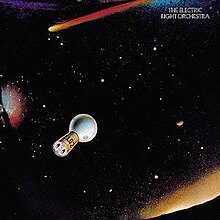ELO 2
| ELO 2 | ||||
|---|---|---|---|---|
 |
||||
| Studio album by The Electric Light Orchestra | ||||
| Released | January 1973 | |||
| Recorded | May – October 1972, Air Studios, London | |||
| Genre | ||||
| Length | 41:48 | |||
| Label |
Harvest (UK) United Artists (US) |
|||
| Producer | Jeff Lynne | |||
| The Electric Light Orchestra chronology | ||||
|
||||
| Singles from ELO 2 | ||||
|
||||
| US alternate album cover | ||||
 |
||||
| Professional ratings | |
|---|---|
| Review scores | |
| Source | Rating |
| Allmusic | |
| Classic Rock | |
| Robert Christgau | C+ |
| ELO 2 (First Light Series) | ||||
|---|---|---|---|---|
| Studio album by Electric Light Orchestra | ||||
| Released | 2003 | |||
| Recorded | 1972–73 at Air Studios | |||
| Genre | Progressive rock, symphonic rock | |||
| Label | Harvest, EMI | |||
| Producer | Jeff Lynne | |||
| Electric Light Orchestra chronology | ||||
|
||||
| Professional ratings | |
|---|---|
| Review scores | |
| Source | Rating |
| Allmusic | |
ELO 2 is the second album by the Electric Light Orchestra (ELO), released in 1973. In the US the album was released as Electric Light Orchestra II. It was also the last album to be released by the band under the Harvest label, the last where the band used the definite article The on its name and introduced their acronym ELO.
The album was originally to be titled The Lost Planet, but that concept was quietly dropped (see below). During the initial recording sessions, Roy Wood left the band and formed Wizzard in early 1972. Although uncredited at the time, Wood performed on two tracks, playing cello and bass on "In Old England Town" and "From the Sun to the World". Classically trained cellists Colin Walker and Mike Edwards replaced Wood, and Wilfred Gibson played on violin. Richard Tandy made his ELO studio debut on this album, playing keyboards; he had earlier performed live with the original lineup, playing bass (and in TV appearances with The Move playing guitar). Bassist and vocalist Mike de Albuquerque also made his ELO studio debut on the album. All five pieces are longer than standard rock songs, and feature multi-layered orchestral instruments that create a dense, complex sound.
Along with its predecessor it is the least commercial-sounding album the band released, although ironically it did reach the British Top 40 album chart, whereas its more concise follow-up, On the Third Day, did not; an edit of "Roll Over Beethoven" was a Top 10 hit in Britain and received radio airplay in America too. In 2006 the album was remastered and expanded in the US, with a slightly different running order to the UK 2003 EMI version, with both versions sharing the same Hipgnosis album art for the first time.
The British and American sleeves differed, as did the title; in the UK it was released in a gatefold sleeve titled ELO 2 with a painting of a light bulb travelling through space with the wording 'ELO2' on the base of the bulb, while in the US the cover featured a more ornate light bulb against a night sky and was titled Electric Light Orchestra II. For reasons unknown, "Roll Over Beethoven" was slightly edited in length compared with its US counterpart. Track 2 "Momma" was Americanised to "Mama" for the US release. An instrumental version of "In Old England Town", the opening track, became the B-side to the single "Showdown". The album contains the band's longest track, the anti-war song "Kuiama".
...
Wikipedia
